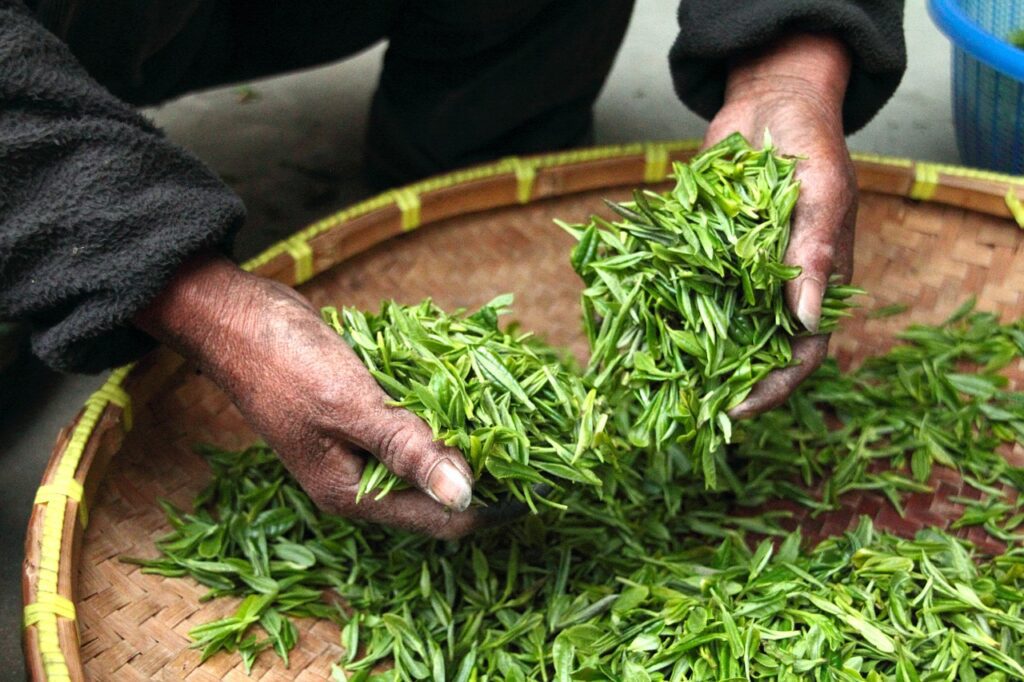Ho trovato poche nozioni sulla donna e il tè, eppure sono spesso le donne a raccogliere il tè nelle piantagioni.
Pensate che occorrono tantissime foglie per raccogliere un giusto quantitativo per la lavorazione. Se la raccolta viene effettuata a mano ritiene molte ore. La raccolta a mano è quella che preleva il germoglio apicale e le due massimo tre foglioline sottostanti con cui si crea il tè più pregiato.
Solitamente viene raccolto in grandi cesti e le donne stanno sotto il sole diverse ore con il capo ricoperto. Le piante vengono portate alla giusta altezza di un metro e venti per facilitare la raccolta da parte delle raccoglitrici, che coi loro abiti colorati prelevano le foglioline con estrema cura proprio perché la raccolta meccanizzata rischierebbe di rompere le foglie e cominciarne l’ossidazione.
Il tè dello Yunnan è uno dei più noti e proprio nello Yunnan esiste un villaggio chiamato il Paese delle Donne.
In questa società le donne sono libere di allevare i bambini mentre i loro uomini lavorano durante il giorno, ma anche di esprimere la loro creatività attraverso lavori femminili e danze popolari, restando individui unici.
Ci troviamo al confine con il Tibet a circa 2000 metri. Proprio in questi luoghi si estendeva la Via della Seta dove venne esportato il tè nella storia e scambiato spesso coi cavalli.
Infatti il tè venne trasportato inizialmente dalla Cina verso il Tibet, finché nello Yunnan nacquero le prime piantagioni.
In cinese Yun vuol dire nuvola e Nan significa sud, ovvero “la città a sud delle nuvole”.
Esiste un canto di questi luoghi che cita:
“Senza tè la terra bianca, non ha tè ma solo acqua. Senza sale la terra bianca non ha sale ma solo acqua. Ascoltate i gong i mercanti a cavallo sono arrivati. La terra bianca adesso avrà il tè, il sale e acqua.”
The harvesters of Yunnan

I have found little knowledge about women and tea, yet it is often women who collect tea on plantations.
Think that it takes a lot of leaves to collect the right amount for processing. If the harvest is done by hand it takes many hours. Harvesting by hand is that which takes the apical bud and the two maximum three underlying leaves with which the finest tea is created.
It is usually collected in large baskets and the women stay in the sun for several hours with their head covered. The plants are brought to the right height of one meter and twenty to facilitate harvesting by the foragers, who with their colorful clothes pick up the leaves with extreme care precisely because mechanized harvesting would risk breaking the leaves and starting their oxidation.
Yunnan tea is one of the best known and there is a village in Yunnan called the Country of Women.
In this society women are free to raise children while their men work during the day, but also to express their creativity through feminine works and folk dances, remaining unique individuals.
We are located on the border with Tibet at about 2000 meters. It was in these places that the Silk Road extended, where tea was exported throughout history and often traded with horses.
In fact, tea was initially transported from China to Tibet until the first plantations were born in Yunnan. In Chinese Yun means cloud and Nan means south, which is the city south of the clouds.
There is a song from these places that mentions:
“Without tea, the white earth has no tea but only water. Without salt, the white earth has no salt but only water. Hear the gongs the merchants on horseback have arrived. The white earth will now have tea, salt and water. “

Le foglie del tè vengono lavorate a mano per non danneggiare i teneri germogli e le foglie più pregiate.



No responses yet